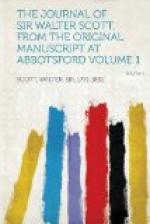“Asturis ungue Leo Pullum
rapiens Aquilinum
Hic deplumavit, acephalumque
dedit.”
The other lines, in the Church, of more modern date, are conceived in a humaner spirit, and may possibly be those which touched the heart of the old worshipper of chivalry.
Ossibvs et memoriae Conradini de Stovffen, vltimi ex sva progenie Sveviae dveis, Conradi Rom. Regis F. et Friderici II, imp. nepotis, qui cvm Siciliae et Apvliae regna exercitv valido, vti hereditaria vindicare proposvisset, a Carolo Andegavio I. hvivs nominis rege Franco caeperani in agro Palento victvs et debellatvs extitit, deniqve captvs cvm Frederico de Asbvrgh vltimo ex linea Avstriae dvce, itineris, ac eivsdem fortvnae sotio, hic cvm aliis (proh scelvs) a victore rege secvri percvssvs est.
Pivm Neap. coriariorvm
collegivm, hvmanarvm miseriarvm memor, loco
in aedicvlam redacto,
illorvm memoriam ab interitv conservavit.
(For the details of the death of Conradin and the stories connected with his memory see Summonte, Storia di Napoli, vol. ii. Celano, Notizie di Napoli Giornata Quarta, and St. Priest, Histoire de la Conquete de Naples, vol. iii.)
* * * * *
No. V.
“Mother Goose’s Tales,” p. 459. The following note by a distinguished authority on Nursery Tales, will be read with interest.
“It is unfortunate that Sir Walter Scott did not record in his Diary the dates of the Neapolitan collection of ‘Mother Goose’s Tales,’ and of the early French editions with which he was acquainted. He may possibly have meant Basile’s Lo Cunto de li cunti (Naples, 1637-44 and 1645), which contains some stories analogous to those which Scott mentions. There can be no doubt, however, that France, not Italy, can claim the shapes of Blue Beard, The Sleeping Beauty, Puss in Boots, and the other ‘Tales of Mother Goose,’ which are known best in England. Other forms of these nursery traditions exist, indeed, not only in Italian, but in most European and some Asiatic and African languages. But their classical shape in literature is that which Charles Perrault gave them, in his Contes de ma Mere l’Oie, of 1697. Among the ‘early French editions’ which Sir Walter knew, probably none were older than Dr. Douce’s copy of 1707, now in the Bodleian. The British Museum has no early copy. There was an example of the First Edition sold in the Hamilton sale: another, or the same, in blue morocco, belonged to Charles Nodier, and is described in his Melanges. The only specimen in the Public Libraries of Paris is in the Bibliotheque Victor Cousin. It is probable that the ‘dumpy duodecimo’ in the Neapolitan dialect, seen by Scott, was a translation of Perrault’s famous little work. The stories in it, which are not in the early French editions, may be L’Adroite Princesse, by a lady friend of Perrault’s, and Peau d’Ane




